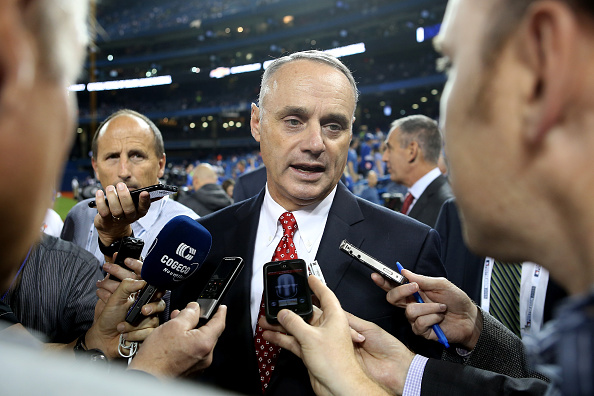A new strike zone could be on its way to Major League parks around the country, while the procedure for intentional walks is on its way out. Changes to both were approved by MLB’s competition committee last week at the owners meetings, and could be implemented as early as next season.
The committee agreed on a motion to raise the lower part of the strike zone to the top of the hitter’s knees. The current rules state that the zone begins at “the hollow beneath the kneecap.” However, umpires are calling more and more strikes below the knees causing more punch-outs.
As for intentional walks, they will still be around but the way teams go about them will change. Instead of a pitcher throwing four pitches, a team could simply signal it wants to issue an IBB, and the hitter would be immediately sent to first base.
The changes won’t go into effect until they are approved by baseball’s playing rules committee, which is chaired by Mets general manager Sandy Alderson. Sources said the changes would also be presented to the MLB Players Association as part of negotiations for a new labor agreement. However, the rules committee doesn’t need MLBPA’s approval to implement the changes.
These new rules are just the latest by-product of Rob Manfred’s concerns about the pace of play. Eliminating the traditional intentional walk would cut down on “dead time,” while the adjustment to the strike zone (in theory) will produce more balls in play, more offense and more “action.” 30% of hitters in the average game either walk or strike out, the highest rate of “non-action” in baseball history.
The number of strikes on pitches in the lower 3rd of the strike zone has been on the rise. pic.twitter.com/KFpdBFyWGS
— ESPN Stats & Info (@ESPNStatsInfo) May 21, 2016
Neil Walker, second baseman for the Mets, has already voiced support for raising the strike zone.
“I think if you ask hitters, most of the complaints they would have would be about low strikes,” he said. “They’re probably the hardest to call for umpires, and catchers have gotten so good at presenting them.”
However, he thinks it will cause more walks, not more balls in play.
“As a hitter, when you see the ball out of the pitcher’s hand and it’s going to be down, you usually think about taking it, because it’s harder to do damage with that pitch,” he said. “Us as hitters, we want that ball up, thigh or mid-thigh.”
Cubs manager Joe Maddon echoed Walker’s comments,
“Guys might take more pitches, and you’re still going to get a walk,” he said. “It might benefit a team like us if they call it that way because the biggest thing about us would be an umpire that doesn’t expand our strike zone. That’s what we’d love to have.
If you’re going to shorten the strike zone, it can be counterproductive. If a guy is pitching down below that and we’re just taking them, you’re going to get less action. It’s one of those things that you have to put it in play to answer the question.”
As for getting rid of the traditional intentional walk, Maddon wasn’t sold.
“By taking that away, there is the potential that a wild pitch could occur that could impact the game. And I’ve seen it happen,” he said.
And like the other die hard fans of the game, Maddon is not concerned about pace of play.
“When it comes down to the game itself, I’m not so pent up on moments like that, however many seconds that takes to get that done.”
What do you think? Are these two changes good for baseball? What other changes do you want to see made?




